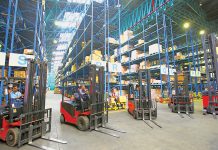Equipping commercial fleets of vehicles with on-board telematic devices can be used to gather intelligence and design the best response to a problem. When these devices are employed in a fleet of trucks, it may be especially advantageous to a logistics company, opines Vineet Sharma, CEO and Co-founder, Fleetx.
With the threat of cargo theft, vehicle breakdowns, road rage, and other such hindrances, running a logistics business has never been easy – especially when timely delivery is directly linked to the success of the business. And, when it is in India, you also have to account for bad roads in most parts. To mitigate such issues, modern logistics companies are turning to newer and more efficient technology-led solutions like telematics.
What is telematics and how does it work?
We are quite familiar with the concept of global positioning system (GPS), which we often find used in fleets of taxi services. This is just one example of things facilitated by a technology called telematics. A combination of telecommunication and informatics, telematics uses technological tools to enable intuitive and real-time monitoring of fleets and a timely redress of any snags that might occur.
Commercial fleets of vehicles can be fitted with on-board telematic devices to collect raw data in real time and pass them on to software management companies, which process and turn these into vital information to draw intelligence from and plan the best solution to a problem at hand. It can be particularly beneficial for a logistics business when these devices are used in their fleet of trucks.
Telematics for logistics business
While telematic devices can be installed in any commercial or personal vehicle, the ones used in trucks are a bit different. These are designed for larger vehicles and geared to collect data on things like fuel usage, road taxes, service hours and vehicle health status. Since trucks undertake longer journeys, often in trying conditions, these devices are equipped to withstand bumpy rides on rougher roads, and have more powerful batteries and are more heavy-duty in their make.
Devices used in truck telematics not only enable live location tracking of trucks out for cargo delivery, but also help monitor driving patterns, fuel efficiency, and the condition of the vehicle to predict snags or breakdowns which might delay a delivery or disturb the logistical supply chain.
How in which truck telematics can address the logistics industry’s woes
Location tracking: Truck drivers have to often brave a lot of hardships on the road to ensure on-time delivery of cargo. They may be hindered by a number of unforeseen events. Remote location tracking through data captured by on-board devices on trucks helps fleet managers and logistics companies send messages and reinforcements to facilitate smoother movement.
Engine monitoring: On-board telematic devices installed on trucks take stock of the engine’s health and send data in real time. These can prove handy in predicting any possible breakdown well in advance.
Speed tracking: A large number of road accidents are caused by over-speeding. When jostling to meet delivery timelines, the tendency to breach allowed speed limits cannot be ruled out. But if over-speeding – not necessarily by the truck driver, but by the driver of any vehicle on the road – leads to an accident, it further delays a delivery and disturbs the supply chain. While it may not be possible to regulate all vehicles plying on the road, the speed at which the supply truck is being driven can be monitored through telematics.
Driving pattern checks: The installed telematic device can monitor the driving pattern against parameters like hard or soft braking, hard or soft acceleration and deceleration, emissions, lane-changing, etc. An analysis of data so gathered can then enable risk-profiling and mitigating measures in order to avoid mishaps.
How truck telematics can help fleet owners and managers
The data collected by truck telematic devices are fed into transport management systems, which analyse and evolve real-time strategies for proper and timely fleet operations. They also help streamline vehicle maintenance and upkeep in order to maintain good vehicular health and functionally robust fleets. By avoiding unforeseen events and ensuring smooth logistics operations, fleet owners and managers not only further the success of their business, but also bring down several cost overheads and increase their profits.












